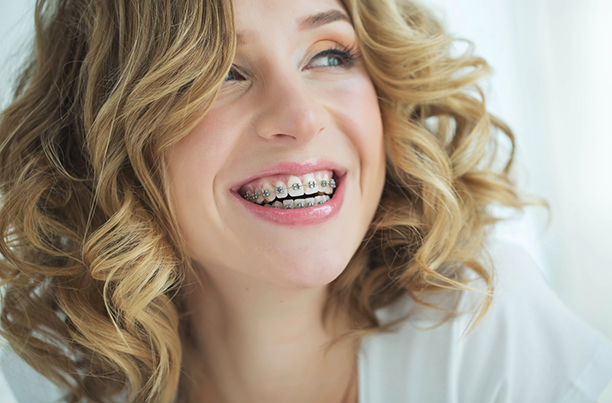Traditional Braces – Worcester, MA
Effectively Treating Even the Most Crooked Smiles

There are more orthodontic options to choose from than ever before, but traditional braces are still considered the standard for good reason. Adjusting the jaws, crooked teeth, and uneven bites is incredibly effective through this treatment. At Super Braces of Worcester, we are proud to provide solutions to Worcester families in need of overcoming challenges like crooked teeth and other smaller problems before they turn into serious ones. Get in touch with us today to schedule an orthodontic consultation and see if traditional braces from our Worcester, MA orthodontist are the right option for your family members. We treat and manage all levels of misalignment and underbite, no matter how severe.
What Should I Expect from Traditional Metal Braces?

At your no-cost consultation, we start by examining your mouth in order to figure out what sort of issues we’ll need to treat. Sometimes, we can start treatment that same day, but if not, at your second appointment, we place the brackets onto your teeth and thread the archwire through them. Each bracket is held in place using a small portion of bonding material, which is applied to enamel after we’ve thoroughly dried its surface. Once the archwire is threaded, we trim it to ensure it does not poke or irritate your gums. Once the series of colored bands are wrapped around the brackets (which are chosen based on your preference and keep the wire in place), you can officially begin your treatment!
How Long Does Treatment Typically Take?

The answer is different for everyone based on their specific orthodontic concerns. While severe or complex orthodontic issues naturally require more time to resolve (and the room available for teeth to shift can also influence treatment length), you’ll also need to take proper care of your teeth. We’ll make sure to provide you with detailed aftercare instructions over the course of your treatment. More often than not, you’ll need to wear braces for about one to three years. Following treatment, a retainer should be worn for up to 12 months to keep teeth in place.
Are Traditional Braces Right for Me?

For severe cases of misaligned teeth, uneven bites, or rotated teeth, traditional braces are the best solution. There are different forms of treatment that may be viable as well, but only if mild to moderate corrections are necessary. Dr. Moon will perform a detailed examination of your teeth and jaw to determine whether or not you or your younger family member require braces. Following the results of this exam, we’ll provide a recommendation that addresses your oral health needs and accounts for your personal preferences and lifestyle. To set up your no-cost initial consultation, call our orthodontic office today!
Understanding the Cost of Traditional Braces

The cost of traditional braces depends almost exclusively on the specifics of your treatment. For example, patients who wear braces for just one year generally don’t end up paying as much as patients who wear the brackets and wires for multiple years. During your initial consultation, our team can evaluate your situation before providing you with an estimate of what you can expect to pay for your personalized orthodontic treatment. In the meanwhile, here’s more about some of the factors that influence the cost of traditional braces in Worcester, along with some ways that you can utilize insurance and other means to lower your out-of-pocket costs.
Factors That Affect the Cost of Traditional Braces
Here are a few of the main factors that affect the cost of braces:
- Severity of misalignment – This is perhaps the most significant factor that contributes to the cost of braces; some patients have teeth that need major movement, need one or both arches to be corrected or have other issues that necessitate complex orthodontic care.
- Patient’s age – Children’s teeth tend to move more quickly than those of adults, since they aren’t as firmly set in the jaw.
- Number of appointments needed – Since braces must be adjusted periodically throughout the treatment process, the frequency of these checkups can impact the total cost of care, too.
- Compliance with treatment guidelines – If you neglect to follow your treatment guidelines, such as not adhering to dietary restrictions or failing to wear your elastics, you can cause delays in your orthodontic journey that add to the total cost of care.
Professional Braces vs. “DIY” Braces: Which Costs More?
Since “DIY” or “do-it-yourself” braces typically come with a lower initial price, many patients might feel tempted to choose them over traditional braces. However, doing things yourself might end up being far more problematic than you’d initially expect. The treatment will lack a comprehensive initial exam conducted by a professional, and you also won’t have an orthodontist monitoring you throughout the process. It might seem cost-effective at first, but it can even lead to worsened issues that require costly treatment in the future. The bottom line is that if you want a reliable solution that also gets you your money’s worth, your best investment is professional orthodontic care.
Does Dental Insurance Cover Braces?
If you have dental insurance coverage, you should know that many policies include at least partial coverage for traditional braces; however, every plan varies from patient to patient, so you should always check the specifics of yours beforehand. That said, braces are more likely to be covered if they’re needed for medical reasons, such as jaw misalignment, rather than just to correct aesthetic issues. Additionally, some plans may only provide braces coverage for younger patients under the age of 18. When you come in for your consultation, our team can help you to navigate the specifics of your coverage to deduce an estimate of how much you’ll be expected to pay.
Options for Making Braces Affordable
If you’re without dental insurance coverage for orthodontic treatment, you aren’t entirely out of luck; there are various ways of lowering the expected cost of care. We’re happy to offer affordable financing through LendingPoint that will allow qualifying patients to pay for their treatment in smaller installments with little to no interest. Additionally, we’re thrilled to offer various other specials and promotions to help you affordably reshape your smile.
Traditional Braces FAQs

At Super Braces of Worcester, our lives revolve around orthodontic treatments. Naturally, that’s not the case for most of our patients, which is why we’re here to answer any questions you have, even if they seem silly. You’re welcome to call us anytime or ask our orthodontist directly at your consultation. Otherwise, you can keep reading to learn the answers to FAQs about traditional braces!
Am I Too Old to Get Braces?
If you’re no longer a young adult, you might be wondering if it’s too late to get braces. Good news: the answer is “no.” In fact, there isn’t technically an upper age limit for orthodontic treatment since candidacy isn’t determined by how old you are. Instead, factors like the complexity of your case are considered.
It’s also worth mentioning that many adult patients do extremely well with braces since they are investing their own time and money. Plus, orthodontic treatment can benefit the health and function of your smile, and you’re never “too old” for that!
Do Traditional Braces Hurt?
It is normal to experience some discomfort with traditional braces, particularly in the first few days. However, your mouth will adapt to your brackets and wires fairly quickly, so the adjustment period will be quite short.
When it comes to the soreness stemming from the movement of your teeth, there are a few things you can do. To start, stick to soft foods, like plain yogurt, and sip on cool water. You can also take OTC pain medication, which can provide you with the relief you’re looking for.
If your discomfort is due to a sharp bracket or wire, then the best thing to do is use some dental wax to cover it, protecting the soft tissue in your mouth in the process.
What Can You Not Eat with Traditional Braces?
Throughout your orthodontic treatment, you’ll be asked to avoid crunchy, sticky, and chewy foods. This includes (but isn’t limited to) popcorn, raw nuts, potato chips, taco shells, pizza crust, and pretzels. Remember, indulging in these with braces can cause a bracket or wire to snap, requiring an immediate trip to our office. That’s why it’s best to stick to nutrient-dense foods that are on the softer side whenever possible, like scrambled eggs, cooked vegetables, and oatmeal.
What Happens After You Get Your Braces Off?
Once we remove your braces, we will need to take impressions of your teeth for your retainer! This is a crucial step of the treatment process because if you don’t take active measures to preserve your results, your teeth can begin to move out of position (a phenomenon known as orthodontic relapse). The good news is that retainers today are more comfortable and discreet than ever before, which makes wearing them consistently much less of a hassle.
Note: If you’re worried that you will lose your retainer or forget to wear it, then we can have a fixed retainer made!
